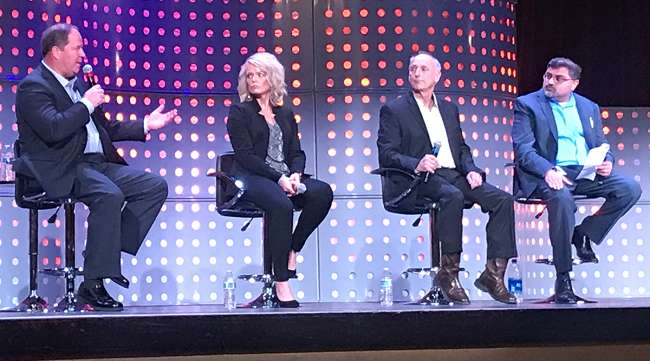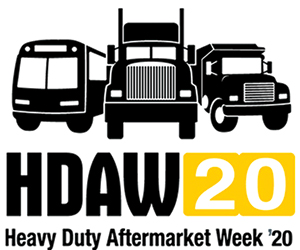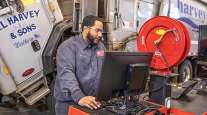Senior Reporter
Fleets Manage Parts in Multiple Ways

[Stay on top of transportation news: Get TTNews in your inbox.]
GRAPEVINE, Texas — Fleets have found various ways to handle the need for parts. Sometimes, it’s expanding inventory levels, or not substituting cheaper but less reliable ones for critical parts, doing some warranty work themselves, keeping the average age of trucks low or turning to electric trucks, carrier executives said.
They made their comments during Heavy Duty Aftermarket Dialogue 2020, presented by the Motor & Equipment Manufacturers Association and MacKay & Co.
Electric trucks are expected to have 33% fewer parts compared with trucks with an internal combustion engine, experts said, and that suits PepsiCo Inc., which is preparing to add to its fleet of electrified vehicles. It has 300 Class 6 battery-electric vehicles among 3,500 in that segment.

They are driven 80 to 90 miles a day in urban delivery and then sit idle for 12 to 14 hours and are charged in the same way as passenger cars are. “That [duty cycle] is very conducive for electrification,” said Keshav Sondhi, PepsiCo’s director of fleet maintenance and sustainability.
The company is looking at Class 8 electrified vehicles, he said. In the past, there weren’t a lot of choices.
“This go around, given that there is a push by major original equipment manufacturers, having parts available and dealers to work on it, we are really excited,” he said.
PepsiCo, which began using battery-electric trucks 10 years ago, ranks No. 1 on the Transport Topics Top 100 list of the largest private carriers in North America.
The company also intends to reduce greenhouse gas emissions by 20% by 2030 compared with 2015 levels and offset every atom of carbon that comes from growth of its fleet in that period, Sondhi said.
“How do we do that in 10 short years? We have to remove a lot of traditional fossil fuels,” he said.
Rounding out the day at #HDAD20 with our Fleet Perspective panel, including Tanya Morrow of Ploger Transportation, LLC, Bob Phipps of Bettendorf Trucking, Scott Reed of Werner Enterprises, & Keshav Sondhi of PepsiCo! pic.twitter.com/RFvyief6Dh — Heavy Duty Manufacturers Association (@HDMADialogue) January 27, 2020
Bettendorf Trucking has seven shops and hauls wood byproducts, bulk livestock feed, lumber, and flatbed, general freight and refuse.
“It comes down to who can deliver a consistent, good quality part at a price they can make a living at and we can afford,” said Bob Phipps, the carrier’s maintenance supervisor.
“We use a couple of wholesale distributors, and the rest of our parts come from dealers,” he said. “As far as preference goes, one thing about this industry: It is a people-based industry, and initiative, attitude and availability go a long way as far as us looking at where we are getting parts from. Price is always big.”
He said he has parts sales representatives’ cellphone numbers and tries not to wake them in the middle of the night.
“We try to plan properly so we don’t have to do that,” Phipps said.
Also at HDAW20
In some cases, that’s meant expanding inventory.
“We keep just about every sensor there is in stock. Because sometimes if you have to get a truck going, it’s better to replace two or three of the top likelihoods. Otherwise, you’ll spend days troubleshooting it,” he said.
Ploger Transportation takes a do-it-yourself stance, President Tanya Morrow said.
Replacing parts at the right time through preventive maintenance “is our crisis management ahead of time,” she said.
The carrier handles some of its own warranty work, too.
In part one of a two-part exploration of autonomous technology today, our latest RoadSigns podcast revisits conversations with CEOs Alex Rodrigues of Embark and Cetin Mericli of Locomation. Hear them explain what testing automated trucks and developing platooning technology has taught them about the road ahead — and get new perspective with host commentary. Listen to a snippet from Rodrigues above, and to hear the full episode, go to RoadSigns.TTNews.com.
“However, we don’t get into anything deep as far as engine work or transmission work,” she said. “We will take that to the dealer, at that point.”
Werner Enterprises has flipped a little more than 60% of its business to dedicated contract carriage, and the rest is longhaul — the opposite of where it was four years ago, said Scott Reed, senior vice president of fleet purchasing and maintenance.
Dedicated contract carriage has put a lot demand on outside maintenance and getting relationships and agreements, he said.
“We have been in business more than 60 years, so we have great relationships with vendors. Dedicated has just created a much more demanding situation to get our equipment up and going,” Reed said.
Meanwhile, Werner used to run its fleet upward of 650,000 to 700,000 miles before selling them.
“That was basically through 2010 up until the end of 2015,” he said. “So we dealt with a lot of those diesel particulate filter issues. A lot of it was the technology was not very good at that time. It has gotten much better. The way we took care of that issue is we buy late-model equipment now.”
The average age of Werner’s fleet is 1.8 years, Reed said.
Want more news? Listen to today's daily briefing:





